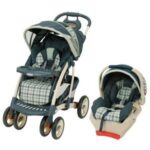Now the kids are back in school and you have some free time to think and plan for the year, it’s beneficial for parents/guardians to reeducate themselves on what must be done to keep your little ones safe in the car.
Often referred to as our most precious cargo, children can be strapped into a car seat, but without following strict details on which kind is appropriate and and to safely secure them in it is a whole different matter.
The Centers for Disease Control and Prevention (CDC) recently sent out a report from 2008, “Four children, ages 14 or younger, were killed in motor vehicle crashes every day, and many more were injured.
The saddest part of this statistic is that most of these deaths could have been prevented by guardians properly buckling their kids in the appropriately fitting car seat.
Children 12 years and younger are required to be seated in the back seat of all vehicles. They cannot handle the impact of a front seat airbag if it is deployed. This also includes rear-facing car seats.
The CDC says, “In 2008, restraint use saved the lives of 244 children ages 4 and younger. Child safety seats reduce the risk of death in car crashes by 71% for infants and 54% for toddlers ages one to four.
Booster seats can dramatically reduce injury by over 50%, instead of only using seat belts.
“Protect the Ones You Love” Initiative
The leading cause of child injury in the United States is improperly securing children in automobiles. The CDC launched “Protect the Ones You Love” . Here is a synopsis:
Rear-Facing Seats: Infants must be correctly strapped into a child safety seat in the back seat of the automobile in a rear-facing position. Keep babies rear-facing until they are both “over 1 year old” and “at least 20 pounds.
If your automobile is able to do so, your infant is safest in the middle portion of the back seat, so if side impact in a crash occurs, the baby is far from either door.
Front-facing Seats: When your child qualifies for their seat to face the front of the car, they must remain in the back seat. Each car seat has a manual which lists the individual upper height and weight limit. The average is 40 pounds and age four, but refer to your seats requirements for safest results.
It is also important to make sure the five-point harness is secure and placed above their breast bone. You don’t want it to low to cut into their internal organs and not too high to cut into their throat.
Booster Seats:These seats must also remain in the back seat for safest restraint.
Make sure the automobile’s manufactured safety belt is pulled snugly across the lap and chest of child – kids must remain in a booster seat until they are over 8 years old and over 4’9″ tall. If the lap portion of the belt is not snug across their legs and crossing the chest correctly, the child can be ejected from the seat with the right impact.
Adult Seat Belts: After the child has outgrown their booster seat, they are allowed to use the adult seat belt, but they still need to be kept in the back seat strapped in correctly.
Even though many children will protest this, don’t forget…the back seat is going to always be a safer place for your child until they are over 12 years old.
And it never hurts to make sure your children who are old enough to latch their seat belts are wearing them correctly. Keep an eye on them throughout your trip in the car.
Many police stations and Children’s hospitals have car seat safety checks periodically. Call either close to you before installing a new car seat. It never hurts to have a professional install it correctly into your automobile!



